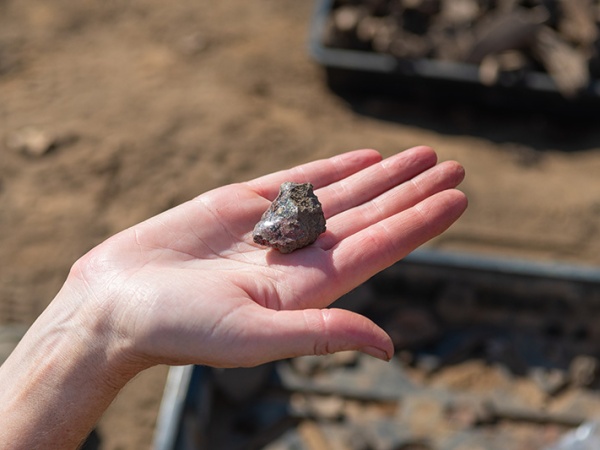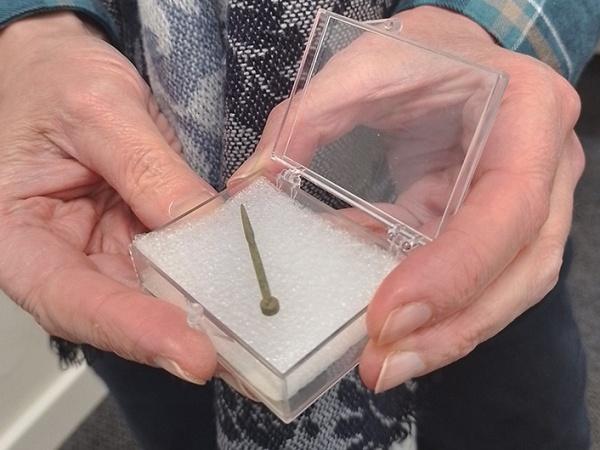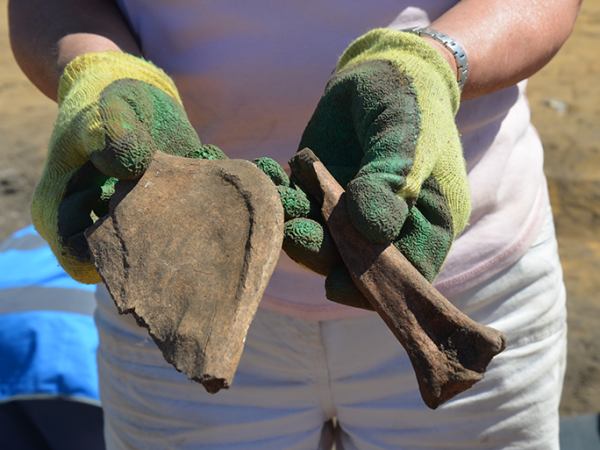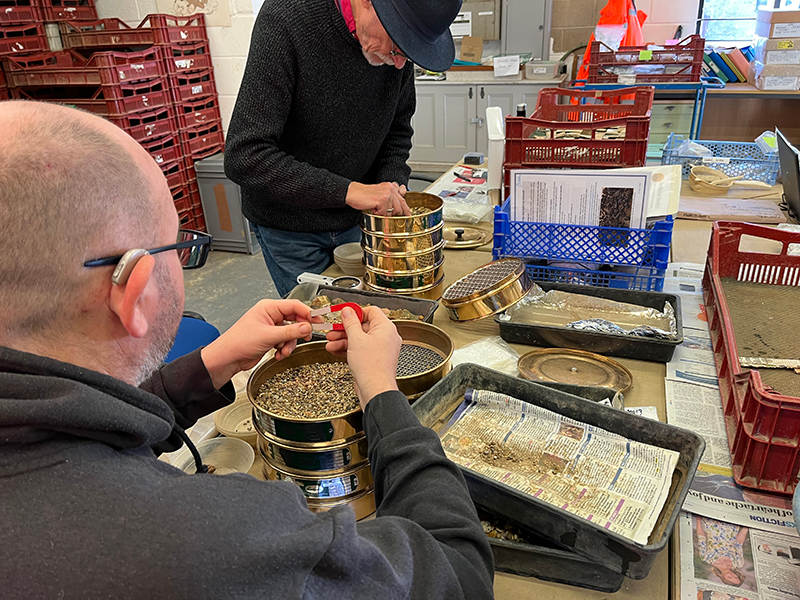Featured image: Drone photograph of the excavations at Rendlesham, showing the excavated hall and boundary ditch (right hand trench) and associated rubbish dump (left hand trench). (© Suffolk County Council; photo by Jim Pullen)
The second season of Rendlesham Revealed excavations are now complete and have unearthed some exciting discoveries.
Evidence of a 1,400 year-old royal Hall of the first Kings of East Anglia has been discovered in Rendlesham, Suffolk.
The foundations of the large and elaborate timber Hall built for the kings, were uncovered by a community archaeological excavation, part of Suffolk County Council’s Rendlesham Revealed project.
It confirms that this site is the royal residence as recorded in the writings of The Venerable Bede of the 8th century.
The Hall, 23m long and 10m wide, is part of a royal compound covering an area of six hectares, set within a larger settlement of over 50 hectares. For 150 years between AD 570 and AD 720 this was the centre from which a major province of the East Anglian kingdom, focused on the valley of the River Deben, was ruled.
Bede’s writings identified Rendlesham as the place where the East Anglian King Aethelwold stood sponsor at the baptism of King Swithelm of the East Saxons between the years AD 655 and 663.


Professor Christopher Scull, the project’s principal academic advisor (Honorary Visiting Professor, School of History, Archaeology and Religion, Cardiff University), said:
“The results of this season’s excavation are of international importance. Rendlesham is the most extensive and materially wealthy settlement of its date known in England, and excavation of the Hall confirms that this is the royal residence recorded by Bede.
“Only at Rendlesham do we have the wider settlement and landscape context of an early English royal centre together with an assemblage of metalwork that illuminates the lives and activities of its inhabitants across the social range. Together, these are radically re-writing our understanding of the sophistication, complexity and international connections of society at that time.
“It has been wonderful working with our terrific team of partners and volunteers, who should be proud of what they have achieved. Their work is a major advance in our understanding of the early East Anglian Kingdom and the wider North Sea world of which it was a part.”


The excavations took place over two trenches (40m x 30m and 30m x 15m in size), revealing:
- the foundations of the large timber Hall (first identified by aerial photography in 2015)
- the perimeter ditch enclosing the royal compound
- the remains of food preparation and feasting which show the consumption of vast quantities of meat, mainly beef and pork
- dress jewellery, personal items, fragments of glass drinking vessels and pottery
- traces of earlier settlement and activity on the site in the early Roman period (1st century AD) and the early Neolithic period (4th millennium BC)
The East Anglian kingdom, covering modern day Suffolk and Norfolk, was made up of several such regions and the Kings travelled between them to rule and to be seen.
The excavated building would have been one of several such monumental Halls in the royal compound at Rendlesham. Here, the first Kings of the East Angles, accompanied by their household and armed retinue, would have administered justice, received tribute and diplomatic envoys, feasted their followers, and distributed gifts and favours.
In earlier years, archaeological investigations have recovered precious metalwork and coinage indicative of the wealth and status of those who stayed here. The nearby burial mounds at Snape and Sutton Hoo are two of the known Princely Burials associated with this royal settlement.
The discoveries came during the second summer of excavations by the community archaeology project ‘Rendlesham Revealed: Anglo-Saxon Life in South-East Suffolk.’ It is run by the Suffolk County Council Archaeological Service, supported by Cotswold Archaeology and funded by The National Lottery Heritage Fund, who awarded a grant of £517,300 for the four-year project, which was made possible thanks to National Lottery players.


Councillor Melanie Vigo di Gallidoro, Suffolk County Council’s Deputy Cabinet Member for Protected Landscapes and Archaeology, said:
“The council’s Archaeological Service has had another hugely successful summer, overseeing work which tells us even more about our county’s and country’s history, and how people lived their lives more than a thousand years ago. It can’t be underestimated how important this part of Suffolk is to our understanding our local and national heritage.
“I’d like to thank the landowners for their support and enabling us to carry out the excavations on their private land. All the volunteers, local school children and charities are also key to making this happen. They tell us that they’ve gained so much from this unique experience, from making new friends, to being in touch with their history, to having space and activities to benefit their mental health.”
Over 250 volunteers from the local community were involved, including young adults from the Suffolk Family Carers and Suffolk Mind, and over 100 local school children from Rendlesham, Eyke and Wickham Market primary schools.
Keiron Whall, Young Carers Advisor at Suffolk Family Carers, said:
“Suffolk Family Carers support young people from all over Suffolk, affected by a family member who has a long term illness or condition. This opportunity for 8 of our Young Carers, aged 12-16, to be involved in the archaeological fieldwork has been an exciting new experience, offering them respite from their day-to-day challenges. The archaeology team made the young people feel so welcome and supported, teaching them new skills. We look forward to working with the project again in the future.”

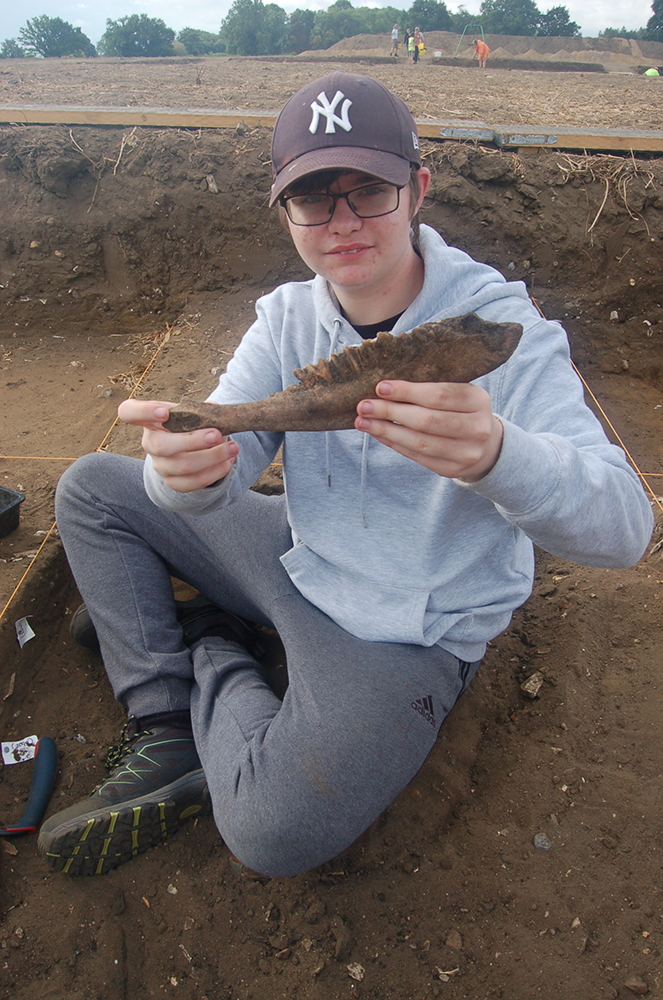
Excavations for this summer are now complete and have been backfilled. Work will soon be underway to analyse the finds with provisional results expected in 2023.
Further fieldwork for Rendlesham Revealed will take place in Summer 2023 and local people will again be able to sign up and volunteer. If you are interested in volunteering for the next season of fieldwork, you can join our e-newsletter mailing list to receive updates.
Find out more
Read about Suffolk Mind’s experience volunteering with the project
Discover more about the Rendlesham Revealed project
Explore last year’s community fieldwork discoveries
Learn about the previous archaeological investigations since 2008
This fieldwork is part of the community archaeology project Rendlesham Revealed: Anglo-Saxon Life in South-East Suffolk, funded by the National Lottery Heritage Fund. We are very grateful to our many local and national partners who have made this project possible, and for the support of our volunteers and of the landowners and farmers who work and manage this historic landscape.
If you want to get involved with the Rendlesham Revealed project and future fieldwork, you can sign up to our e-newsletter for updates.


